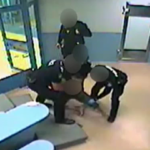Court Declines to Issue Guideline Judgment for the Offence of Assaulting Police

In late 2002, the NSW attorney general Bob Debus applied to the NSW Court of Criminal Appeal for a guideline judgment in relation to the offence of assault police, which is a crime contained in section 60(1) of the Crimes Act 1900 (NSW) which carries up to 5 years prison time.
Made under section 37 of the Crimes (Sentencing Procedure) Act 1999 (NSW), the request sought a panel of NSWCCA justices to produce an authoritative guideline judgment to assist judicial officers in sentencing in relation to that particular crime in order to produce consistent outcomes.
Guideline hearings, which can be initiated by the court itself if it deems it necessary, involve input from the Senior Public Defender, the NSW Director of Public Prosecutions and the NSW attorney general.
The initial offences relating to assaulting police officers were enacted in 1997. And over the five years following, the overwhelming majority of proceedings in relation to the offence of assault police under section 60(1) had been heard in the NSW Local Court and had involved over 500 offenders.
The section 60(1) offence of assault police is listed in table 2 of schedule 1 of the Criminal Procedure Act 1986 (NSW), which means that unless the prosecution specifies otherwise, the offence is dealt with in the Local Court, where there is a 2 year limit on sentences being handed down.
Debus requested a police assault guideline as he considered the perception was the crime was prevalent, while in his view a pattern of manifestly inadequate sentences had emerged. He therefore came to the view there was a need for reform to ensure sentences reflected the seriousness of the offence.
Various assault police offences
Section 60(1) of the Crimes Act makes it an offence to assault or throw a missile (projectile) at a police officer, as well as to stalk, harass or intimidate an officer, while they’re on duty and when no actual bodily harm is inflicted.
As then NSW Chief Justice James Spigelman explained in his 20 December 2002 final findings that the crime is similar to the offence of common assault, under section 61 of the Crimes Act, which carries up to 2 years inside and/or a $5,500 fine, except that this crime is committed against a police officer.
Section 60(2) of the Crimes Act contains the crime of assaulting a police officer and occasioning actual bodily harm, which carries 7 years imprisonment, and, as his Honour further pointed out, is similar to assault occasioning actual bodily harm, under section 59 of the Crimes Act.
And section 60(3) contains the offence of wounding or causing grievous bodily harm to a police officer, or recklessly causing actual bodily harm to them, which makes one liable to up to 12 years imprisonment, and is similar to causing grievous bodily harm to a civilian under section 35.
Since the 2002 NSWCCA guideline hearing, four more offences have been inserted into section 60 of the Crimes Act.
An amendment to the Crimes Act in 2006 in relation to gangs resulted in the passing of section 60(1A), which contains assault police during a public disorder, and it carries up to 7 years imprisonment.
Further section 60(2A) contains the offence of assault police occasioning actual bodily harm during a public disorder, carrying up to 9 years inside, as well as section 60(3A), which contains the offence of wounding or causing grievous bodily harm to an officer during a public disorder, carrying 14 years.
And following the COVID-19 lockdown, state parliament passed legislation in relation to assaults upon frontline emergency and health workers, which contained the crime of hindering or resisting a police officer in executing their duties, and it carries up to 12 months inside and/or a $2,200 fine.
Minimum sentencing standards
The panel of justices deliberating on the question of an assault police guideline judgment on 22 November 2002 also noted that, three days prior, the Crimes (Sentencing Procedure) Amendment (Standard Minimum Sentencing) Act 2002 had reached royal assent with some significant reforms.
These included inserting section 3A into the Crimes (Sentencing Procedure) Act, which provides the purposes of sentencing. These include adequate punishment, deterrence, community protection, promotion of rehabilitation and accountability, the denouncing of conduct and recognising harm.
Further section 21A of the same Act was replaced with new provisions relating to factors that aggravate a crime or make it more harmful in its impact, along with mitigating factors, which lessen culpability. And the first aggravating factor relates to crimes perpetrated against a police officer.
And the last major reform was the standard non-parole period framework contained in division 1A of the same Act, which provides suitable non-parole periods for certain serious crimes to act as a guide post when determining the minimum prison time before an inmate is eligible for release on parole.
Ensuring adequate punishment
The NSW attorney general accepted that the prevalence of assault police as a crime was not the strongest point to bring about consideration of the handing down of a guideline judgment, so he placed more emphasis for such a ruling on the manifestly inadequate sentencing pattern that had emerged.
Debus first requested a guideline judgment in May 2002, but as the hearing drew nearer that following November, the attorney amended his request in light of the minimum sentencing standards about to come into effect on 1 February 2003, so they could be incorporated into the guideline.
In handing down his judgment, Justice Spigelman noted the need for deterrence in relation to assaults on police, as officers need protection in carrying out their duties, and that’s why penalties relating to the harming of police officers are a number of years higher than for assaulting civilians.
His Honour also set out that the AG was not seeking a numerical guideline specifying how much time an offender should be sentenced to over police assault, but rather, it was the nature of the penalty, so that any assault upon police with any aggravating factor present should result in full time custody.
But if an aggravating factor wasn’t a feature of a police assault, Debus considered three other factors that, if present, should result in full time custody. These were that the assault challenged authority, it occurred in presence of the public and whether the officer was alone or was in a remote location.
An inappropriate request
The then Chief Justice outlined that the first difficulty with such a guideline is that common assault is a broad crime that doesn’t result in actual or grievous bodily harm, and it could comprise of tapping someone on the shoulder or pushing them in the chest or holding a gun to a police officer’s head.
“With respect to an offence the gravity of which can vary so greatly, the court should be very slow to adopt a guideline even of the limited character for which the attorney contends in this case,” his Honour added.
The second reason that Justice Spigelman gave in regard to why such a guideline judgment would be inappropriate is that there had never been a Crown appeal against a sentence handed down over police assault, which would suggest that the prosecution has always found the outcome adequate.
“This court should be slow to come to a conclusion that there can be detected any systematic pattern of leniency in sentences by magistrates in a context where the Crown has not exercised its right to lodge appeals against the leniency of sentences at all,” the then Chief Justice set out.
Guideline judgments should only be handed down when there is a clear pattern of inadequate sentencing outcomes, but in fact, no one had been appealing the sentences that were being imposed in relation to assault police, so there wasn’t an issue.
The Senior Public Defender added that the guideline judgment request was premature considering the minimum sentencing provisions that were about to take effect early the following year, and the impact of these new laws would not be realised until sometime after roll out.
And it was this point that led Justice Spigelman to decline issuing a “guideline judgment of the character sought”.
While the remaining four judges deliberating over this question, then Chief Judge at Common Law James Wood and then NSWCCA Justices Michael Grove, Brian Sully and Bruce James, all agreed with the determination of the then NSW Chief Justice.








